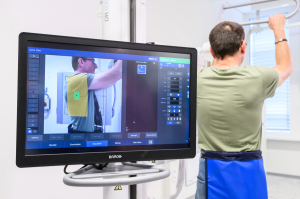by
Lisa Chamoff, Contributing Reporter | November 15, 2021
From the November 2021 issue of HealthCare Business News magazine
Smart automation continues to be a major trend in the radiography market, with several new systems equipped with cameras and sensors that assist technologists with patient positioning and radiation dose reduction, and improving exam workflow.
Detectors continue to get lighter and some are even glass-free.
Here's a look at the new systems, software and detectors.
Agfa US Corporation, Radiology Solutions
At RSNA 2020, Agfa Radiology Solutions launched SmartXR, a solution for the company’s DR 600 ceiling-mounted X-ray room and the DR 100s mobile X-ray that helps guide technologists through proper patient positioning and optimally aligns the detector, tube and images.
The solution combines integrated sensors and cameras with AI, which George Curley, director of marketing and communications for the North American Imaging Business Unit of Agfa, compared to newer cars.
“It’s really there to help the ‘driver’, not take over,” Curley said. “Technologists are still completely in control of the system.”
The company has plans to add SmartDose, which uses IR to measure the front of the patient and SID, and uses the information to tailor exposure parameters.
“It measures thickness of patient and recommends going up or down from the default technique” Curley said. “For portables, it’s going to be extremely helpful.”
Canon Medical Systems USA
In January 2021, Canon Medical Systems released the OMNERA 500A, a new ceiling-mounted, auto-positioning system that was FDA cleared in November 2020. The system features ergonomics and “intelligent automation” to address workflow challenges, said Jay Aboujaoude, managing director of the X-Ray business unit for Canon Medical Systems USA.
Ergonomic features include a motorized, tilting wall stand with automated alignment and tracking, and updated, multi-position wall stand handrail that makes it more comfortable for patients. The automation also means less repetitive arm, shoulder and hand movements for technologists, reducing the risk of fatigue and injury.
“The wall stand is fully automated and so it takes less effort to move system,” Aboujaoude said.
There is also ambient lighting that provides information on system readiness and an open pedestal table with a lower height capability that allows easier patient transfers from stretchers, wheelchairs and Hoyer lift units. A tube head with a special glass overlay display that is free of edges for easier cleaning and disinfection, and fanless motors allow for quiet operation.
